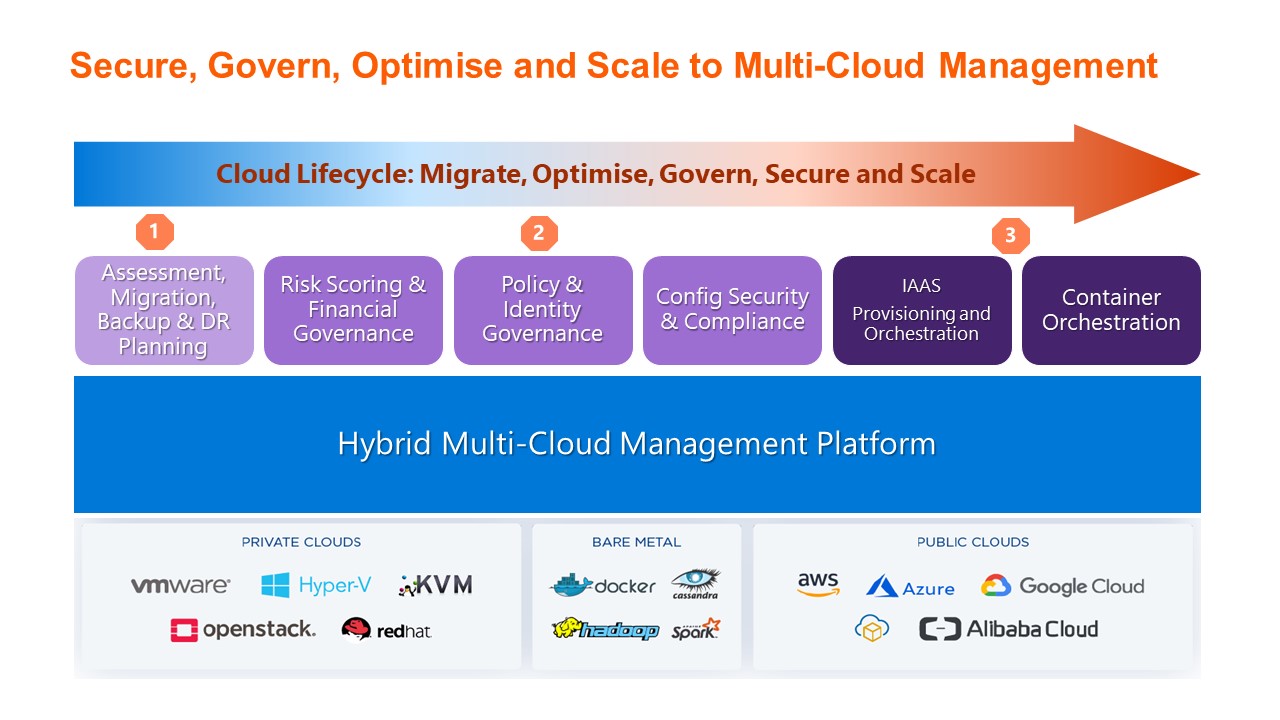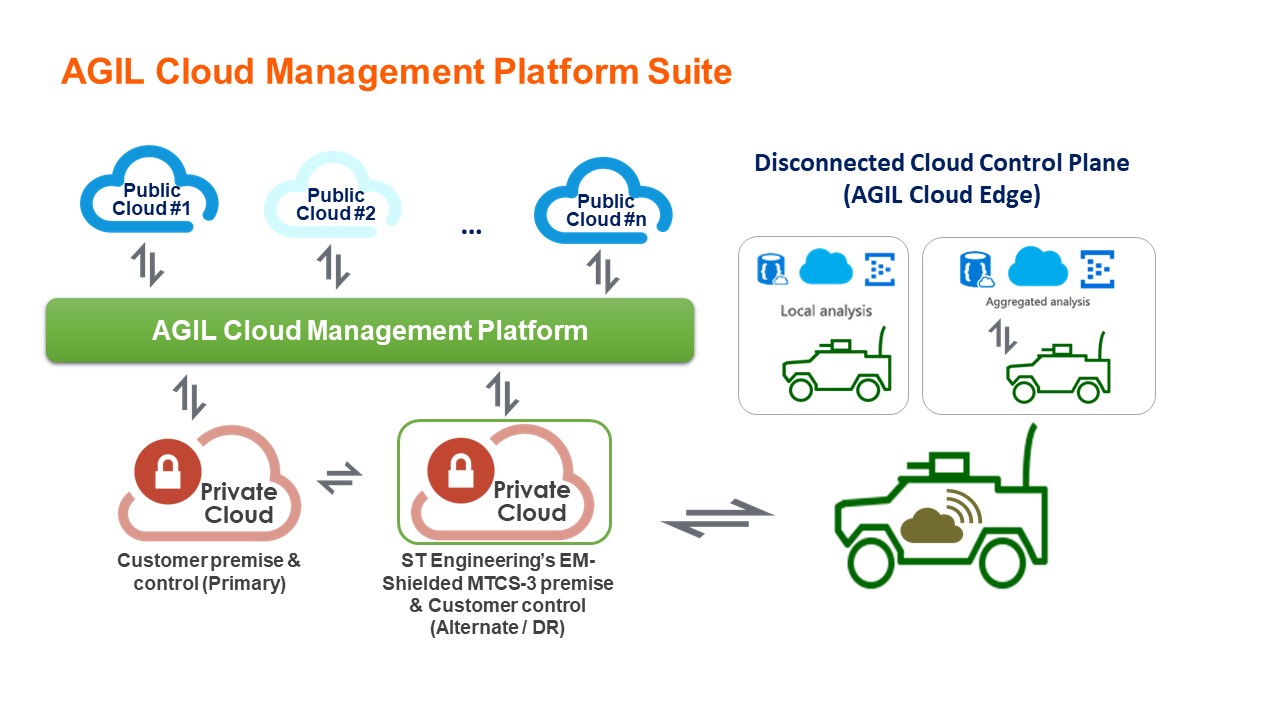Managing your existing and new cloud services with a versatile cloud management platform
A glimpse to an actual scenario. A CCTV footage from a warehouse in western Singapore is regularly reviewed by security staff through a video analytics application on a public cloud. But sometimes, poor Internet connectivity will result in prolonged buffering.
Unperturbed, the management simply shifts the application via a tool to an internal cloud server in the east, where a second warehouse is located. In less than a minute, another team there is able to view the footage due to better connectivity.
While it’s not new, Cloud computing has gained interest as disruptions caused by the COVID-19 outbreak driving organisations to adopt technology at a faster rate. It is clear that the Public Cloud has become an essential tool that empowers people and workplaces to work and operate seamlessly in this digital transformation.
According to a 2020 survey by computer software firm Flexera, 93 per cent of enterprises have a multi-cloud strategy, which includes public cloud services like Amazon Web Services (AWS), while 87 per cent adopt a hybrid cloud strategy, which uses servers hosted in both private and public cloud environments.
However, post-migration challenges within the cloud lifecycle remain. As companies begin to harness the power of cloud technology to digitise and transform their operations, they now need to think about the next step: how to protect their data and scale up operations.
To do that, having a hybrid multi-cloud strategy – using multiple public and private cloud services that are optimised, secured and well-governed is key.

Without a doubt, using a versatile tool to empower organisations to manage their cloud strategy securely on a single platform is critical to bring the multi-cloud strategy to fruition.
Having discussed with our customers on their mounting optimisation, security and governance challenges, the need for an integrated platform that designs, builds and manages secure private cloud services seamlessly seems to be the answer.
Here’s sharing 4 key considerations when choosing the right cloud management platform:
1. Seamless operations through optimisation, even at edge
As cloud performances, costs and geographical locations are factors that may impact operations, there is a need to shift workloads for optimal activity. While data in cloud computing is stored in a centralised location, edge computing is a process that brings the data closer to the user without sending it back and forth to the central server.
Assess if the platform enables any of your cloud applications to be shifted to edge-enabled devices when connectivity is poor to the data centre, or when there is a high data transmission (ingress/egress) cost between different clouds. Applications can also be shifted back to cloud computing when it requires more capabilities and resources. This allows users to optimise their operations to avoid unnecessary costs and diversify data residency/sovereignty. In short, they are not putting all their eggs in one basket and there’s a lesser concentration risk.

2. Data governance and better privacy control
To have a centralised view of operations, data governance is crucial and requires the entire control chain to be visible.
To address that, does the platform comes with controls to help users govern their data locations aligning to their governance and privacy policies? For example, if companies have presence in multiple countries, data in one country cannot, or should not be accessible in another country due to regulations. This boosts privacy control by granting access to only specific people orregions who require it.
3. Multiple layers of data protection and cyber resilience
Enhancing security is crucial when massive amounts of data are transferred or stored. The management platform should provide encryption for data in transit through industry standard protocols Transport Layer Security and Secure Sockets Layer, while using hardware security modules and Customer Managed Keys for data at rest.
At the same time, data access is restricted via encryption, code scrambling and zero-trust security – trusting no one by default, even if they are employees. We do this in partnership with cybersecurity firms SecuPi, who provide data masking/obfuscation solutions across endpoints and application interfaces and Polyverse Corporation, whose Polymorphing solutions scramble code/binaries in real time to prevent potential Zero-day attacks and cyber attacks. In this context, we also work very closely with cybersecurity giant Telos, to proactively monitor cloud changes in real time by providing Continuous Monitoring (ConMon) and real-time analysis.
4. Scale operations in a flash
Above all, does the cloud management platform allow you to scale your operations to multiple clouds in different geographical locations in under a minute? For instance, an application from AWS can be migrated to an edge server before shifting it to Microsoft Azure. Cloud provisioning – where a customer acquires a cloud service’s resources – also occurs when migration is completed. The workload portability is a key benefit.
In pursuit of solving the mounting security and governance challenges faced by many customers, and overcoming the above-mentioned key considerations, we have developed the AGIL™ Cloud Management Platform Suite – a platform that designs, builds and manages secured multi-cloud services.

The suite complements and accelerates your journey towards a hybrid multi-cloud strategy. The platform comes with fine-grained control, jointly developed with cloud management company Cloudsphere (formerly HyperGrid), to enable data governance and privacy controls.
It also enables multi-cloud workload portability, allowing workloads to be used to move across any cloud service without modifications. Customers can continue using multiple clouds simultaneously for extended geographic reach, scaling up capabilities and improved availability, which provide them the capability to ensure their workloads stay accessible and available.
Cloud computing is the future of the workplace in the new norm. Companies must be able to achieve optimisation, security, governance and scaling up from a single control point. AGIL Cloud Management Platform Suite helps companies to configure and maintain a hybrid multi-cloud strategy that will build operational resilience and agility, and ensure businesses’ technology operations running, even when the world is forced to a standstill.
Contact us